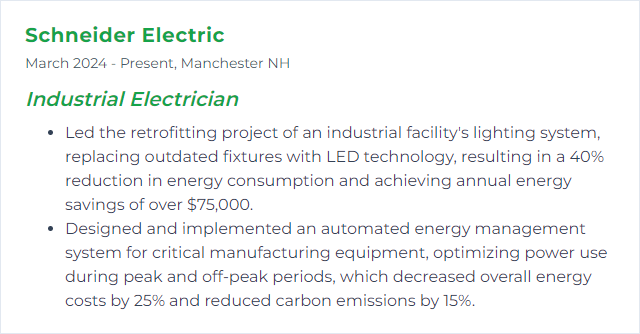Top 12 Industrial Electrician Skills to Put on Your Resume
In today's tight job market, standing out as an industrial electrician takes more than raw technical chops. A sharp, well-rounded skill set on your resume signals versatility, safety-first thinking, and the confidence to wrestle complex systems into line—exactly what hiring managers scan for.
Industrial Electrician Skills
- PLC Programming
- Motor Control
- VFD Setup
- Electrical Troubleshooting
- Schematic Interpretation
- NEC Compliance
- Arc Flash Safety
- Instrumentation Calibration
- SCADA Systems
- Power Distribution
- Robotics Maintenance
- Energy Management
1. PLC Programming
PLC programming means designing, modifying, and testing control logic that runs industrial equipment through programmable logic controllers. You turn process intent into reliable sequences—monitoring, interlocking, alarming, and optimizing with languages defined by IEC 61131-3 (ladder, function block, structured text, and more).
Why It's Important
Automation lives or dies by the quality of its control logic. Strong PLC skills drive uptime, productivity, and safety, while making changeovers and troubleshooting faster and far less painful.
How to Improve PLC Programming Skills
Nail the fundamentals: Data types, scan cycles, task priorities, tags and addressing, IEC 61131-3 languages, and safe states.
Practice with purpose: Use simulators or test racks to build sequences, fault routines, and startup/shutdown logic. Create interlocks and try to break them.
Adopt structure: Modular code, reusable function blocks, clear naming, comments that explain intent, not the obvious.
Version control: Track changes and test branches before deploying. Document why a change was made.
Diagnostics first: Bake in status tags, watchdogs, detailed faults, and trend hooks so troubleshooting is quick and surgical.
Learn multiple platforms: Become fluent in at least two major ecosystems. Each has quirks—learning both makes you faster everywhere.
Safety integration: Understand safety-rated PLCs, STO circuits, and risk reduction techniques. Never leave safe states to chance.
How to Display PLC Programming Skills on Your Resume
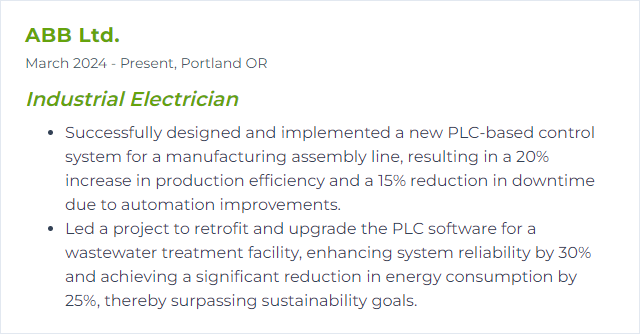
2. Motor Control
Motor control covers starting, stopping, speed/torque control, direction, protection, and coordination for AC and DC motors—across DOL, soft starters, VFDs, servo systems, and safety circuits.
Why It's Important
Precise, protected motor control means fewer failures, tighter process control, and safer operations. It also saves energy and extends equipment life.
How to Improve Motor Control Skills
Master the hardware: Contactors, overloads, relays, drives, encoders, and feedback devices. Know what fails, why, and how to test it.
Apply the right method: Choose DOL, soft start, or VFD based on load type, duty cycle, and process needs. Tune ramps, torque limits, and braking.
Protect wisely: Selective coordination, thermal modeling, ground fault, phase loss, and overload settings matched to nameplate data.
Cable and grounding: For VFDs, use proper shielded cable, bonding, and routing to curb EMI and nuisance trips.
Preventive maintenance: IR scans, megger tests, bearing checks, alignment, and periodic torque checks on terminations.
Document and label: Schematics and parameter lists that mirror the field reality. Keep a golden copy of drive parameters.
How to Display Motor Control Skills on Your Resume
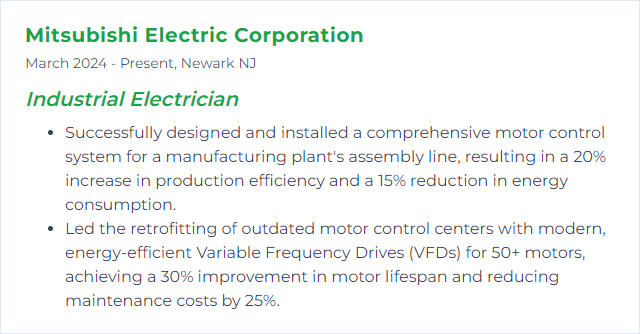
3. VFD Setup
VFD setup is the configuration of a variable frequency drive to match the motor and application—speed, torque, acceleration, braking, and protections—while keeping noise, heat, and harmonics in check.
Why It's Important
Done right, VFDs slash energy use, smooth processes, and shield mechanical systems from abuse. Done wrong, they spawn trips, heat, and mysterious gremlins.
How to Improve VFD Setup Skills
Size accurately: Base on motor nameplate, duty, altitude, cooling, and overload needs. Consider service factor and inertia.
Wire and bond correctly: Follow manufacturer torque specs, use proper shielding and grounding, and separate power and control runs.
Set core parameters: Motor FLA, base speed, accel/decel, current limits, torque limits, control mode (V/Hz vs vector), and braking options.
Tame harmonics and EMI: Input reactors, DC chokes, line filters, and best-practice routing to calm the noise.
Manage heat: Respect clearances, airflow paths, and panel cooling. Dust and heat kill drives early.
Use application macros: Fans and pumps behave differently than conveyors or winders. Start with the right template, then fine-tune.
Back up parameters: Save a known-good set. Nothing beats a fast restore under pressure.
How to Display VFD Setup Skills on Your Resume
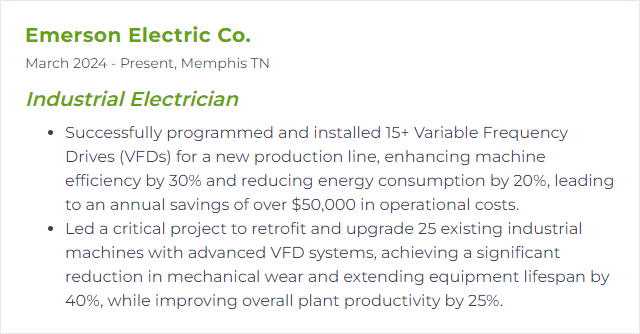
4. Electrical Troubleshooting
Electrical troubleshooting means diagnosing faults in power, control, and instrumentation circuits—methodically, safely, repeatably—until the root cause is pinned down and eliminated.
Why It's Important
Fast, safe fault-finding cuts downtime, protects equipment, and prevents repeat failures. It’s the difference between guesswork and craftsmanship.
How to Improve Electrical Troubleshooting Skills
Read the map: Become fluent in schematics, loop drawings, and panel layouts. Trace signals end to end.
Test like a pro: Use a calibrated multimeter, clamp meter, insulation tester, and power quality tools. Verify your instruments before and after use.
Start safe: Lockout/tagout, verify absence of voltage, and set boundaries. PPE matched to the hazard.
Think in halves: Split the problem—power side vs control, input vs output. Isolate, test, narrow, confirm.
Reproduce and prove: Replicate the fault, fix, then verify under load. Capture data so the fix becomes knowledge.
How to Display Electrical Troubleshooting Skills on Your Resume
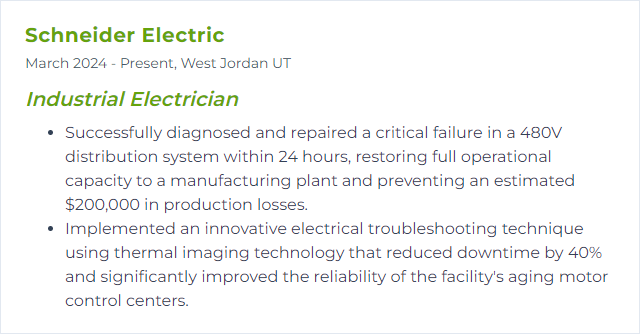
5. Schematic Interpretation
Schematic interpretation is the art of turning drawings into action—understanding symbols, device functions, wire numbers, cross-references, and how the whole thing breathes when energized.
Why It's Important
Accurate installs, quick diagnostics, safer work. If you can read it cleanly, you can build it, fix it, and improve it.
How to Improve Schematic Interpretation Skills
Master symbols and conventions: IEC/ANSI symbols, revision clouds, wire codes, terminal numbering, and flag references.
Follow signal flow: From source to load, from sensor to logic to actuator. Annotate as you go.
Cross-check: Compare single-line, three-line, loop sheets, and panel layouts to catch discrepancies before they bite.
Build mental models: Explain the sequence out loud. If you can teach it, you understand it.
Stay current: New symbols and practices evolve. Review updates and company standards regularly.
How to Display Schematic Interpretation Skills on Your Resume
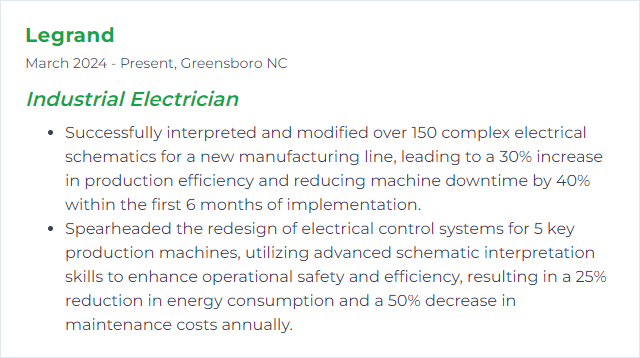
6. NEC Compliance
NEC compliance means installing and maintaining electrical systems to meet the National Electrical Code requirements. It underpins safety, reliability, and inspection success across industrial facilities.
Why It's Important
Compliance reduces shock, arc, and fire risks, protects people and assets, and keeps projects on schedule. Inspectors notice the details.
How to Improve NEC Compliance Skills
Know the latest edition: Study changes in the most recent NEC (for example, 2023) and how they affect industrial installations.
Plan with the code: Apply Articles for wiring methods, overcurrent protection, grounding and bonding, hazardous locations, and industrial control panels.
Document thoroughly: Calculations, short-circuit and coordination studies, arc energy reduction measures, labeling, and as-builts.
Pre-inspect your work: Use checklists. Fix what you find before anyone else does.
Train and refresh: Regular code classes and jobsite tailboards to keep the team aligned.
How to Display NEC Compliance Skills on Your Resume

7. Arc Flash Safety
Arc flash safety combines risk assessment, safe work practices, engineering controls, labeling, and PPE to protect workers from explosive energy released during faults. It aligns closely with NFPA 70E guidance and IEEE arc flash calculation methods.
Why It's Important
Arc events cause catastrophic burns and injuries. Proper boundaries, procedures, and PPE turn high-risk tasks into controlled work.
How to Improve Arc Flash Safety Skills
Do the study: Short-circuit, coordination, and incident energy analysis. Update when systems change.
Label everything: Clear labels with boundaries, incident energy, and required PPE on all relevant equipment.
Establish safe conditions: De-energize when possible. Verify absence of voltage. Ground where required.
Right PPE, right task: Face shields, balaclavas, gloves, FR clothing, and voltage-rated tools matched to the hazard.
Engineer out risk: Arc energy reduction, remote racking, maintenance switches, and better coordination.
Train, drill, repeat: Practical exercises, job briefings, and continuous refreshers—aligned to the latest NFPA 70E edition.
How to Display Arc Flash Safety Skills on Your Resume
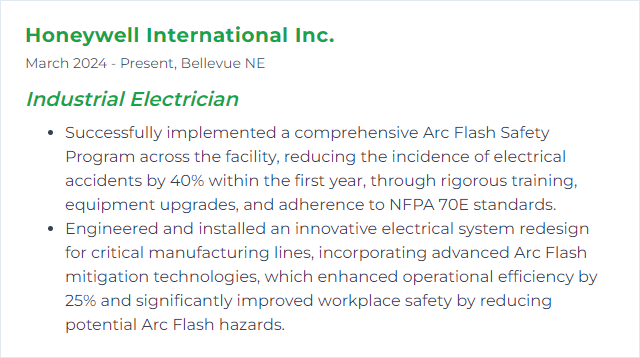
8. Instrumentation Calibration
Instrumentation calibration aligns instruments to known standards so measurements are accurate, stable, and traceable—pressure, temperature, flow, level, and electrical signals alike.
Why It's Important
Good data drives good control. Calibration keeps loops honest, compliance intact, and processes on target.
How to Improve Instrumentation Calibration Skills
Traceability matters: Use standards traceable to national/international references. Record uncertainties.
Control the environment: Stabilize temperature and humidity during calibration. Reduce drafts and vibration.
Follow procedures: Zero, span, linearity checks, as-found/as-left records, and loop checks (4–20 mA, HART/Fieldbus).
Schedule intelligently: Calibrate based on criticality, drift history, and manufacturer guidance.
Document everything: Digital certificates, technician ID, instruments used, results, and tolerances. Audit-ready always.
Train the team: Proper handling, warm-up times, isolation practices, and safety when breaking into live loops.
How to Display Instrumentation Calibration Skills on Your Resume
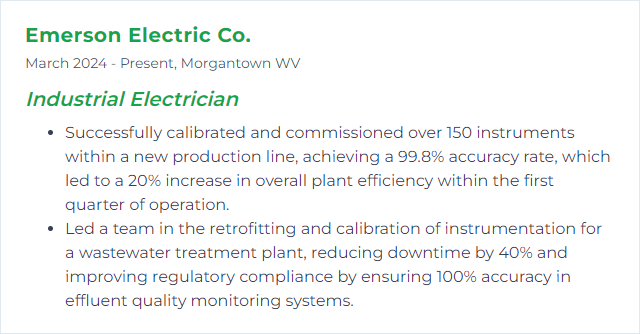
9. SCADA Systems
SCADA—Supervisory Control and Data Acquisition—pulls in real-time data from the field, visualizes it, and commands equipment. It ties PLCs, RTUs, networks, HMIs, historians, and alarms into one responsive picture.
Why It's Important
With SCADA, you see faster, decide smarter, and act sooner. Less downtime, better decisions, safer plants.
How to Improve SCADA Systems Skills
Harden security: Network segmentation, allowlists, least privilege, secure remote access, and regular patching.
Design for resilience: Redundant servers, communications paths, power, and critical PLC links. Test failover.
Clean architecture: Separate control, SCADA, and business networks with a DMZ. Standardize naming and alarm philosophies.
Tag hygiene: Consistent naming, scaling, deadbands, and engineering units. Good tags make great HMIs.
Operator-first HMIs: High-performance graphics, alarm shelving, trends that tell stories, and navigation that’s frictionless.
Data you can use: Historian, KPIs, and analytics for predictive maintenance and energy insight. Time-sync with NTP/PTP.
Backup and test: Regular image backups, configuration exports, and disaster recovery drills.
How to Display SCADA Systems Skills on Your Resume
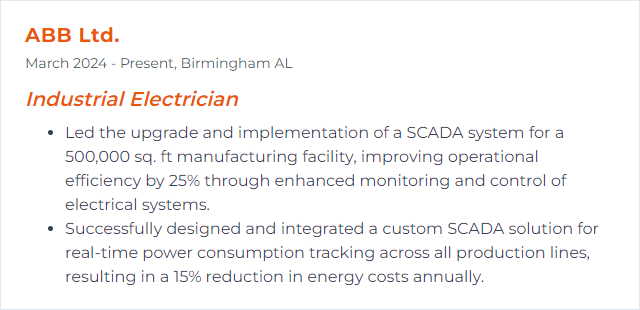
10. Power Distribution
Power distribution routes electricity from sources to loads through transformers, switchgear, panels, and protection—safely, efficiently, and with room to grow.
Why It's Important
Strong distribution design minimizes outages, protects equipment, and keeps energy costs in check. Weak design does the opposite.
How to Improve Power Distribution Skills
Survey the system: Load studies, short-circuit calculations, and arc-flash analysis. Know the baseline before you build.
Selective coordination: Set breakers and fuses so only the nearest device trips. Faster clearing, smaller impact.
Arc energy reduction: Apply code-accepted methods and maintenance modes on upstream breakers.
Power quality: Address harmonics, transients, and low power factor with filters, surge protection, and correction equipment.
Thermal vigilance: IR scans and torque checks to catch loose connections and hot spots early.
Grounding and bonding: Low-impedance paths and consistent practices across the facility. Noise drops, safety rises.
Plan for growth: Spare capacity, space, and conduits. Label like tomorrow depends on it—because it does.
How to Display Power Distribution Skills on Your Resume
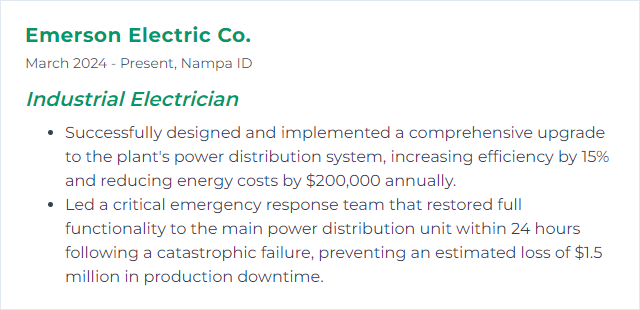
11. Robotics Maintenance
Robotics maintenance keeps industrial robots and cobots reliable—mechanics, drives, I/O, safety, and software—so production keeps humming.
Why It's Important
Less downtime, longer robot life, steadier quality. Repairs cost; prevention pays.
How to Improve Robotics Maintenance Skills
Follow the intervals: Grease, backlash checks, belt tensions, battery replacements, and encoder health—on schedule.
Monitor proactively: Vibration, temperature, cycle counts, and fault trends to predict failures before they land.
Backup everything: Programs, frames, payloads, and safety configs. One click to recover.
Protect people: Lockout/tagout, safety-rated soft limits, area scanners, and verified emergency stops.
Train on the pendant: Jogging, mastering, collision detection tuning, and tool center point calibration.
Spare strategy: Keep critical spares on hand—amplifiers, motors, cables—and verify part numbers match firmware.
How to Display Robotics Maintenance Skills on Your Resume

12. Energy Management
Energy management means tracking, controlling, and reducing energy use across systems and processes—without sacrificing output. Think smarter loads, better timing, and verified savings.
Why It's Important
Lower costs, lighter environmental footprint, and stronger equipment health. Efficiency that shows up on the bottom line.
How to Improve Energy Management Skills
Audit and meter: Install submetering, build baselines, and find the energy hogs—lighting, HVAC, compressed air, and motors.
Target quick wins: VFDs on variable loads, LED lighting, occupancy controls, and leak-hunting on compressed air.
Automate wisely: Use an EMS/BMS for scheduling, demand limiting, and peak-shaving strategies.
Improve power quality: Correct power factor and tame harmonics to reduce losses and penalties.
Maintain relentlessly: Clean filters, aligned drives, tight terminations, and tuned controls keep energy waste down.
Standards and culture: Align to energy management frameworks (such as ISO 50001) and train teams to spot waste.
How to Display Energy Management Skills on Your Resume
